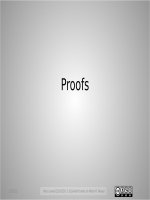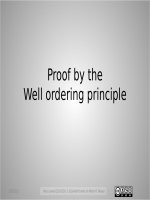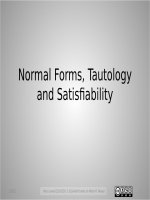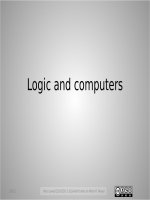Discrrete mathematics for computer science 06normal forms
Bạn đang xem bản rút gọn của tài liệu. Xem và tải ngay bản đầy đủ của tài liệu tại đây (134.01 KB, 6 trang )
Normal Forms, Tautology
and Satisfiability
2/3/12
1
DeMorgan’s Laws
• ¬(p∨q) ≡(¬p∧ ¬ q)
“neither”
– driving in negations flips ands to ors
• ¬(p∧q) ≡(¬p∨ ¬ q)
“nand”
– Driving in negations flips ors to ands
• Also law of double negation: ¬¬p ≡p
• By repeatedly replacing LHS by RHS all
negation signs can be pressed against
variables
• ¬ (p∨(q∧r)) ≡ ¬ p∧ ¬ (q∧r) ≡ ¬ p∧( ¬ q∨ ¬ r)
2/3/12
2
Distributive Laws, Normal
Forms
• p∧(q∨r)≡(p∧q)∨(p∧r)
• p∨(q∧r)≡(p∨q)∧(p∨r)
• By applying these transformations, every
formula can be put in either
– Conjunctive normal form (and-of-ors-ofliterals), or
– Disjunctive normal form (or-of-ands-ofliterals)
• ¬ p∨ ( ¬ q∧ ¬ r) is in DNF
• ( ¬ p∨ ¬ q)∧( ¬ p∨ ¬ r) is an equivalent CNF
2/3/12
3
Tautology
• A tautology is a formula that is true
under all possible truth assignments
2/3/12
p
q
¬ (p∧q) ≡ (¬p∨ ¬ q)
T
T
T
T
F
T
F
T
T
F
F
T
4
Satisfiability
• A satisfiable formula is one that is true
for some truth assignment
p
q
T
T
¬ p∧q
F
T
F
F
F
T
T
F
F
F
• A formula is unsatisfiable (last column
all F) iff its negation is a tautology (last
column all T)
2/3/12
5
P = NP?
• One can in principle always determine
whether a formula is satisfiable,
unsatisfiable, a tautology by filling in the
truth table and looking at the last column.
• Each line is easy, but the table for a
formula with n variables has 2n rows.
• n = 100 => 2n >> age of the universe, in
nanoseconds
• Is there a subexponential algorithm?
2/3/12
6









